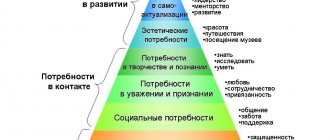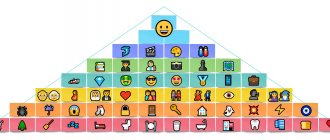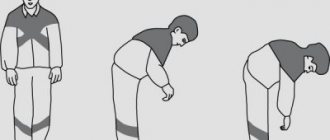Mankind knows many pyramids: the pyramids of Giza, the pyramids of Machu Picchu, the pyramids of Kukulkan and others. They are all phenomenal, each in their own way, and all arouse great interest. But in addition to these unique architectural structures, there are also pyramids of a different kind, which, nevertheless, cause far from weak excitement around them. They can be called intelligent structures. And one of them is the pyramid of needs of Abraham Maslow, a famous American psychologist, the founder of humanistic psychology.
In the online program “Self-Knowledge”, with the help of psychological tests and exercises, you will find out what you really want in life and understand your strengths and weaknesses.
Principles of Maslow's pyramid
Psychologist Abraham Maslow, who worked in the USA in the 20th century, argued that human needs have a hierarchical structure and depend on each other: the satisfaction of each of them entails an increase in ambitions and the emergence of new interests. For example, a person’s financial capabilities do not allow them to meet basic needs: food, their own housing, security. At this stage, a person is worried about survival, he has neither the strength nor the capabilities for further development. Having achieved a stable income and bought their own home, a person begins to think about traveling, starting a family and purchasing courses to improve professional skills.
The more needs are covered, the higher and freer the aspirations and possibilities. To move to a new level, a person needs to close the needs related to the previous one, but variations are possible here.
Maslow emphasized that the principle of distribution of needs may depend on the psychological type of a person. In the value system of an active careerist, family will occupy the last place, and for a creative person, spiritual development is more important than position in society. Some people are not interested in developing higher needs, being content with little, but such changes occur as a result of unfavorable living conditions or under the influence of aggressive external factors.
Theory and practice
According to many modern psychologists, despite the fact that Maslow’s pyramid is a clearly structured model, it is quite difficult to apply it in practice, and the scheme itself can lead to completely incorrect generalizations. If we put all the statistics aside, a number of questions immediately arise. For example, how dark is the existence of a person who is not recognized in society? Or, should a person who is systematically malnourished be considered absolutely hopeless? After all, in history you can find hundreds of examples of how people achieved enormous results in life precisely because their needs remained unsatisfied. Take, for example, poverty or unrequited love.
According to some reports, Abraham Maslow subsequently abandoned the theory he put forward, and in his subsequent works (“Towards the Psychology of Being” (1962), “The Far Limits of Human Nature” (1971)), the concept of personal motivation was significantly refined. And the pyramid, which many specialists in the field of psychology and marketing are trying to find application for today, has generally lost all meaning.
Maslow's pyramid structure
The classic pyramid of needs, according to Maslow’s 1954 work “Motivation and Personality,” includes 5 levels. The main goal of a person is to achieve the fifth level, which is equivalent to the closure of all vital needs.
Level No. 1. Physiological needs
At this stage, it is important to satisfy physiological needs , without which it is simply impossible to lead a normal life:
- satisfying hunger and thirst;
- roof over your head;
- minimal rest, healthy sleep.
This level can be characterized in one phrase: “I got enough sleep, I’m not hungry, I’m not thirsty.” Meeting physiological needs is the basis from which the next levels of the pyramid grow.
Maslow's classic pyramid
Level No. 2. Safety
After satisfying physiological needs, a person needs security. This group includes:
- stability in all areas of life and in the psycho-emotional state;
- confidence in the absence of external threats and dependence;
- consistency in comfort and living conditions.
A person who has reached level 2 of the pyramid is devoid of anxiety, he experiences a certain amount of confidence and is not afraid of global changes.
Level No. 3. Social connections
Man is a social being, therefore, for a comfortable life he needs the following psychological beacons:
- faithful friends;
- support, understanding, care;
- loving family: husband/wife, child/children;
- social contacts with interesting people;
- business partners you can rely on;
- stable social circle.
At this level, it is important for a person to know that he is not alone and belongs to a certain social group.
Level No. 4. Prestige
A person needs a positive assessment, because he has gone through a lot and put a lot of effort into development. At this stage, the main priorities are:
- high social status;
- professional achievements;
- encouragement from colleagues, management, family and friends;
- feeling of self-importance;
- respect, glory, power;
- acquiring a positive reputation.
Recognition of achievements achieved in one area or another is necessary.
Level No. 5. Spirituality (self-actualization)
A person at this level does not experience material problems, he has acquired status and is socially realized, so it’s time to think about self-actualization. There is time to develop spiritual qualities, talents or areas in which there is interest. For example, a person is a successful programmer, but all his life he wanted to learn how to draw - he will satisfy this need after achieving all the others included in the pyramid.
There is an improvement of personality, there is a desire for self-expression. In accordance with the works of Oil, no more than 1.5-2% of the Earth's population moves to this level.
Identification and development of needs
Any task is formed in stages, in several steps. With a healthy psyche, the main ideas are formed at an early stage - before the age of 18-20, then an independent, holistic personality appears. If a child develops slowly and does not realize what he wants, the question of developmental disabilities can be raised.
It is worth noting that most people experience various kinds of changes throughout their lives. This is due to new tasks - this is normal. If a woman does not understand what motivates her, why she makes decisions that are not typical for her, then she has not recognized her own new desires.
In such cases, contact me, I will help you understand yourself. After my consultation, you will feel a surge of strength, analyze your own motives, set goals and realize them.
So, any task is formed in two stages:
- An ideal entity appears - a unique condition for achieving the set goals. This ideal for activity is gradually becoming more specific and acquiring logical features.
- The concept is transformed into a concrete form and is realized. It begins to move intentions and actions.
Let me give you an example. A person first feels emptiness, a desire to get closer to others. Then he realizes that this feeling is a need for love. And only when full awareness occurs, this goal contributes to the emergence of the task - to find a beloved man/woman in order to realize one’s own intentions.
Maslow's Extended Pyramid
In later works, the pyramid was supplemented with two levels, located between prestige and spirituality:
- cognitive needs: knowledge, skills, desire for research, creation. There is a desire to learn, gain new knowledge and expand the range of hobbies;
- aesthetic needs: beauty, harmony, order. A person feels a desire to travel, visit exhibitions and museums, develop culturally, enjoy the beauty of nature and peace of mind.
Abraham Maslow developed only the theory of needs; it was put into table form by other scientists (about 15-20 years after the publication of the scientific works of the American psychologist). Over the years, the pyramid has not lost its relevance; today it is used by analysts, marketers and other sales representatives who seek to better understand potential buyers.
Maslow's Extended Pyramid
Criticism
The main reason for criticizing Maslow's pyramid is its hierarchy, as well as the fact that needs cannot be completely satisfied. Some researchers interpret Maslow's theory in a generally unflattering way. According to their interpretation, the pyramid suggests that man is an animal that constantly needs something. And others say that Maslow's theory cannot be applied in practice when it comes to business, marketing and advertising.
However, the author did not adapt his theory to business or advertising, but only tried to answer questions in which, for example, behaviorism or Freudianism came to a dead end. Maslow simply sought to provide insight into human motivation, and his work is more philosophical than methodological.
Pros and cons of Maslow's pyramid
Maslow's pyramid has a number of advantages that are valuable not only for psychologists, but also for marketers:
- better understanding of customer needs and values;
- building the right sales strategy and marketing campaigns;
- optimization of marketing processes related to segmentation of the target audience and the formation of a unique selling proposition;
- correct assessment of personal perception characteristic of different groups of clients;
- objective comparison of life priorities.
Some principles of Maslow's pyramid are considered outdated: all needs included in the structure cannot be satisfied. However, Maslow's pyramid is the basis from which Alderfer's ERG (three needs) theory and other classification systems were developed.
Highest human needs
From Maslow’s hierarchy of needs outlined above, it follows that higher needs correlate with such aspects of a person as his personality and mind. They are connected with culture and represent, as already mentioned, the need to understand the world and one’s personality, the development of this personality and self-realization. According to Maslow himself, the percentage of people who truly satisfy the highest need - self-realization - is only 1-2%.
How to Use Maslow's Needs Theory in Marketing
Development of commercial and unique selling propositions
Having identified the client's needs, the business will be able to speak the same language with him. For example, an online store delivers ready-made food. The store's customers are people who want to quickly satisfy their hunger after a hard day at work or returning from a business trip. They are not ready to wait for a long time, so the advertising campaign is based on the slogans “We will deliver in 30 minutes”, “Get your order for free if it is not delivered within 1 hour”, “A quick snack like grandma’s” and others. It makes no sense to offer gourmet delicacies to a person who plans to quickly eat pizza while in the middle of a traffic jam.
Clients of online stores selling expensive jewelry or watches gravitate towards elements of prestige. Because of this, marketing campaigns for high-budget products use the words “unique,” “premium,” and “limited editions.” After determining the client’s place in the pyramid, you can develop proposals that will work effectively here and now, reflecting the specifics of the business and leveling objections.
Adaptation to changing customer requirements
The needs of potential buyers are changing, due to the growth of sales markets and the introduction of new services. Over the past 10 years, messenger marketing, door-to-door delivery, augmented reality applications, and online tools on websites that allow you to calculate prices or select clothing sizes have gained popularity. If an online store cannot offer in-demand services, then customers will go to competitors. The formation of new proposals is carried out on the basis of needs analysis.
Gaining loyalty
Elements of Maslow's pyramid are often integrated into loyalty marketing strategies. They are based on three basic principles that have similar features to the theory of needs:
- at the first level, the client goes through transactional loyalty: he chooses a product, service or services, receiving benefits. The customer spends money, but at the same time, physiological needs are met and a feeling of security is formed, consonant with confidence in the seller;
- By moving to the second level of the program, the client receives recognition. The online store has a comprehensive amount of information about the buyer, and he receives more benefits, which is an incentive to increase loyalty. The client develops a feeling of mutual respect and social belonging;
- working with customer experience. The online store satisfies the client’s obvious and hidden needs, for which he makes purchases and returns to the seller again. The buyer feels important, he is ready to work for the benefit of the company, so he starts active word of mouth.
By guiding the client through all stages, the marketer has the opportunity not only to start the sales process, but also to acquire a loyal customer who will willingly advertise the brand or company. Based on this data, loyalty programs, referral programs and sales funnels, as well as advertising campaigns (contextual, social networks, etc.) are formed.
What types of needs exist?
There are several classifications, but the most developed and widespread is by origin. There are:
- Biological. They are also physical or material. These include all needs that are innate in nature. In many ways, they are similar to the instincts of animals and should be one of the first to be realized. Much depends on their implementation, on some - directly the life of the individual, on others - the development of the human species. This category includes the need for food, reproduction, and warmth (hence the desire to be in comfort). If you get stuck on this lower level, serious psychological problems can begin, including those associated with overeating or, in general, with a consumer type of consciousness, when the individual no longer has tasks other than buying items and clothes.
- Social. They are personal. Each of us is in society, is a direct part of it. At the same time, we play the roles of wife, mother, daughter, employee, customer. The basis of each mask is both typical (general stereotypes, norms) and individual. The higher the level of individuality, the brighter the personality traits are drawn. This type includes all spiritual and social aspirations, including the development of relationships and careers. The most significant needs include work and communication. Everyone needs rest, but you need to relax after work.
- Spiritual or existential. They represent the most complex set of desires, since they are formed on the basis of real cultural experience and knowledge. There are people who do not experience significant impact from these needs because they are fixated on the first two categories. These include everything that connects a particular individual with the world - not only from a social point of view, but from a moral one. This is art, creativity, self-realization, development.
According to these three varieties, the basic types of human needs can occasionally be replaced with each other. For example, let’s imagine a creative person, an artist, a creator. He can spend a day at a canvas and feed on inspiration alone. Here we see how the biological basis has temporarily given way.
In addition to the one presented, there are many classifications based on different principles:
- by origin: natural and imparted by society (eat / eat in a cafe);
- in the direction: material and spiritual (buy a fur coat / love animals);
- by field of activity: communication, professional (communicate / get promoted);
- by origin: endogenous and exogenous, that is, appearing on their own, from the inside, or grafted by people or external conditions - any organism must be nourished, but only those who are in a cold climate receive twice as much heat.
Also in the professional literature there is a division into basic and acquired. According to this concept, some form the foundation and are indisputable, while others are subject to adjustment and discussion.
A. Maslow's theory
The most popular classification of needs (also known as hierarchy) is Maslow’s pyramid. The American psychologist ranked needs from lower to higher, or from biological to spiritual.
- Physiological needs (food, water, sleep, that is, everything related to the body and organism).
- The need for emotional and physical security (stability, order).
- The need for love and belonging (family, friendship), or social needs.
- The need for self-esteem (respect, recognition), or the need for evaluation.
- The need for self-actualization (self-development, self-education, other “self”).
The first two needs are considered lower, the rest are higher. Lower needs are characteristic of a person as an individual (biological being), higher needs are characteristic of personality and individuality (social being). The development of higher needs is impossible without satisfying the primary ones. However, after their satisfaction, spiritual needs do not always develop.
Higher needs and the desire for their realization determine the freedom of human individuality. The formation of spiritual needs is closely related to the culture and value orientations of society, historical experience, which gradually becomes the experience of the individual. In this regard, material and cultural needs can be distinguished.
There are several differences between lower and higher needs:
- Higher needs develop genetically later (the first echoes appear in late adolescence).
- The higher the need, the easier it is to push it aside for a while.
- Living at a high level of needs means good sleep and appetite, absence of disease, that is, a good quality of biological life.
- Higher needs are perceived by a person as less urgent.
- Satisfaction of higher needs brings great joy and happiness, ensures personal development, enriches the inner world, and fulfills desires.
According to Maslow, the higher a person climbs on this pyramid, the healthier he is mentally and the more developed as a person and individual he can be considered. The higher the need, the more a person is ready for active action.
Which human needs are more important?
On average, a person can simultaneously have more than 10 unmet needs, which are lined up in a “queue”. Maslow suggested that the average person satisfies 85% physiological needs, 70% safety and protection, and 50% love and affection. Self-esteem is important for an individual by 40%, and self-realization by 10%, which is very little when compared with other needs.
If at the moment a person, being at the highest level of the pyramid, feels the need to satisfy the needs of a lower level, he will return there and will remain there until he receives sufficient comfort.
Everything is not permanent
The diagram presented by Maslow is valid, but it is generalized information. People are multifaceted, all personalities are different. One person will need constant accumulation of funds, and the other will need music and creativity. One wants recognition and fame, while the other dreams of a secluded, quiet life. We can say that a person's needs depend on the type of personality. Therefore, the set of basic human needs (besides the basic ones) and their hierarchy differ for each individual.
And also the same need can manifest itself differently in different people. For example, for some, only the opinion of their beloved partner is enough for recognition, while others need to win the hearts of millions of people. It all depends on personal experience, ambitions, character.
Moreover, even for the same individual, the balance of needs changes constantly. Having satisfied the currently dominant desire, a person tends to immediately switch to the next. This happens all my life.
In addition, age greatly influences a person’s needs and the degree to which they are expressed. For example, children and adults need food, sleep and safety. Teenagers want attention and love more than adults, who learn not to depend on other people's opinions. And more mature individuals need self-expression.
Thank you for reading the article to the end and do not forget to share the information on social networks, because it is not difficult for you, but it is pleasant for us.
K. Alderfer's theory
The author empirically modified Maslow's theory and identified three groups of needs, differentiating the need for assessment:
- existence (physiological and the need for safety according to Maslow);
- connectedness (social needs and external evaluation according to Maslow);
- development (internal assessment and self-actualization according to Maslow).
The theory is distinguished by two more provisions:
- several needs may be involved at the same time;
- the lower the satisfaction of the highest need, the stronger the desire to satisfy the lower (we are talking about replacing the inaccessible with the accessible, for example, love with something sweet).
E. Fromm's theory
In Fromm's concept, needs are classified based on the unity of man and nature. The author identifies the following needs:
- The need for communication and inter-individual bonds (love, friendship).
- The need for creativity. Regardless of the type of specific activity, a person creates the world around him and society itself.
- The need for a sense of deep roots that guarantee the strength and security of existence, that is, an appeal to the history of society, the family.
- The need for the desire for similarity, the search for an ideal, that is, the identification of a person with someone or something.
- The need for knowledge and mastery of the world.
It is worth noting that Fromm adhered to the concept of the influence of the unconscious on a person and attributed needs precisely to this. But in Fromm’s concept, the unconscious is the hidden potential of the individual, the spiritual powers allocated to each person initially. And also the element of community, the unity of all people is brought into the subconscious. But the subconscious, like the described needs, is broken by the logic and rationality of the world, clichés and taboos, stereotypes. And most of the needs remain unfulfilled.
D. McClelland's theory of acquired needs
The author identified three needs that a person acquires throughout life:
- need for achievement or accomplishment;
- the need for human connection or affiliation;
- need for power.
According to the author's concept, every person has these needs, but their expression and influence on behavior differ. The development of needs begins in childhood:
- if children are encouraged to control others, then the need for power is formed;
- with independence – the need for achievement;
- when establishing friendship, there is a need for affiliation.
Need for achievement
A person strives to surpass other people, stand out, achieve established standards, be successful, and solve complex problems. Such people themselves choose situations where they will be responsible for everyone, but at the same time avoid being too simple or too complex.
Need for joining
A person strives to have friendly, close interpersonal relationships based on a close psychological connection and avoids conflicts. Such people are focused on situations of cooperation.
Need for power
A person strives to create conditions and requirements for the activities of other people, to manage them, control them, use authority, and decide for other people. A person gains satisfaction from being in a position of influence and control. Such people choose situations of competition, competition. They care about status, not performance.
How to determine client needs using Maslow's pyramid
The following tools are used to determine client needs:
- drawing up a client portrait using Sherrington’s 5W method. The marketer collects information about who the client is, what exactly the business offers, where and under what conditions they will buy this product;
- analysis of consumer interests. An analysis of reactions to different advertising messages is carried out, a map of the client’s journey and click dynamics are studied;
- surveys to identify pain points, budget, needs, age and other individual characteristics of customers from different segments.
Surveys can be conducted on social networks, in a playful way through quizzes, or using Google Forms.
You can ask the client about his needs and expectations directly ; a good solution would be to collect information about the experience of using a similar product and shopping in other online stores. The collected data is systematized, after which the target audience is segmented and campaigns are developed that meet the expectations and interests of each group.
Concept and brief description
Maslow's pyramid is a simplified model of the hierarchical theory of human needs developed by American psychologist Abraham Maslow.
Despite some imperfections, this scheme is used quite widely.
A. Maslow outlined his ideas in 1943 in the work “The Theory of Human Motivation”, and then supplemented them in the book “Motivation and Personality” (1954).
The scientist showed that all individual impulses cannot be reduced to the satisfaction of physiological processes, as was previously stated in psychology. Human nature is hierarchical: after the so-called natural needs come higher ones, and each of them influences thoughts and actions in its own way.











